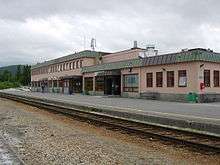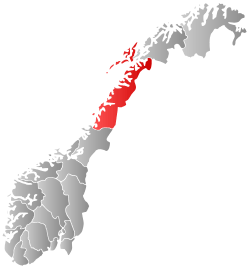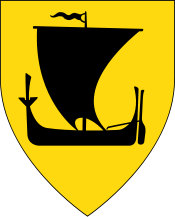Fauske
| Fauske kommune Fuossko | |||
|---|---|---|---|
| Municipality | |||
 | |||
| |||
 Fauske within Nordland | |||
| Coordinates: 67°13′14″N 15°48′31″E / 67.22056°N 15.80861°ECoordinates: 67°13′14″N 15°48′31″E / 67.22056°N 15.80861°E | |||
| Country | Norway | ||
| County | Nordland | ||
| District | Salten | ||
| Administrative centre | Fauske | ||
| Government | |||
| • Mayor (2015) | Jørn Stene (LL) | ||
| Area | |||
| • Total | 1,209.68 km2 (467.06 sq mi) | ||
| • Land | 1,108.42 km2 (427.96 sq mi) | ||
| • Water | 101.26 km2 (39.10 sq mi) | ||
| Area rank | 82 in Norway | ||
| Population (2013) | |||
| • Total | 9,508[1] | ||
| • Rank | 103 in Norway | ||
| • Density | 8.6/km2 (22/sq mi) | ||
| • Change (10 years) | -1.2 % | ||
| Demonym(s) | Fauskeværing[2] | ||
| Time zone | CET (UTC+1) | ||
| • Summer (DST) | CEST (UTC+2) | ||
| ISO 3166 code | NO-1841 | ||
| Official language form | Bokmål | ||
| Website |
www | ||
|
| |||
![]() Fauske is a town and municipality located in Nordland county, Norway. It is part of the traditional district of Salten. The administrative centre of the municipality is the town of Fauske with approximately 6,000 inhabitants. Other villages include Nystad, Straumsnes, and Sulitjelma.
Fauske is a town and municipality located in Nordland county, Norway. It is part of the traditional district of Salten. The administrative centre of the municipality is the town of Fauske with approximately 6,000 inhabitants. Other villages include Nystad, Straumsnes, and Sulitjelma.
The municipality borders Sweden in the east and the municipalities of Sørfold to the north, Bodø to the west, and Saltdal to the southeast. The town is located on the northern shore of the Skjerstadfjorden.
General information

On 1 January 1905, the northern district of the municipality of Skjerstad was separated to become the new municipality of Fauske. Initially, the population of Fauske was 4,646. The municipal borders haven't changed since that time. In 1998, the municipality declared township for its administrative centre.[3]
Name
The municipality (originally the parish) is named after the old Fauske farm (Old Norse: Fauskar), since the first church, Fauske Church, was built there (in 1867). The name is the plural form of fauskr which means "old and rotten tree".[4]
Churches
The Church of Norway has three parishes (sokn) within the municipality of Fauske. It is part of the Salten deanery in the Diocese of Sør-Hålogaland.
| Parish (Sokn) | Church Name | Location of the Church | Year Built |
|---|---|---|---|
| Fauske | Fauske Church | Fauske | 1867 |
| Sulitjelma | Sulitjelma Church | Sulitjelma | 1899 |
| Sulitjelma Chapel | Sulitjelma | 1996 | |
| Valnesfjord | Valnesfjord Church | Valnesfjord | 1905 |
Coat-of-arms
The coat-of-arms is from modern times (1988). The arms show a red reef knot on a gray background. It was chosen to represent Fauske as a center of commerce and transportation for the region.[5]
Economy
Several marble quarries are located in the municipality. The marble is exported to many countries, where it can be observed in many monumental buildings, among them the United Nations Headquarters in New York City. There are also dolostone quarries in Fauske, as well as some agriculture. Salten Kraftsamband and Fauske Lysverk are important employers in Fauske. The town is a commercial centre for parts of the inland areas of Salten, and has hotel and camping facilities. FK Fauske/Sprint is the local soccer team. Historically, mining in Sulitjelma was very important.
Government
All municipalities in Norway, including Fauske, are responsible for primary education (through 10th grade), outpatient health services, senior citizen services, unemployment and other social services, zoning, economic development, and municipal roads. The municipality is governed by a municipal council of elected representatives, which in turn elect a mayor.
Municipal council
The municipal council (Kommunestyre) of Fauske is made up of 27 representatives that are elected to every four years. Currently, the party breakdown is as follows:[6]
| Party Name | Name in Norwegian | Number of representatives | |
|---|---|---|---|
| Labour Party | Arbeiderpartiet | 5 | |
| Progress Party | Fremskrittspartiet | 3 | |
| Conservative Party | Høyre | 3 | |
| Christian Democratic Party | Kristelig Folkeparti | 1 | |
| Red Party | Rødt | 2 | |
| Socialist Left Party | Sosialistisk Venstreparti | 1 | |
| Liberal Party | Venstre | 1 | |
| Local Lists | Lokale lister | 11 | |
| Total number of members: | 27 | ||
Transportation

Photo: Lars Røed Hansen

The Nordlandsbanen railroad passes through the municipality, reaching Bodø west of Fauske. Travellers going further north usually leave the train in Fauske, and travel by express bus to Narvik or further, using European route E6 which goes through the center of Fauske. The E6 from Mo i Rana north to Fauske crosses over the Saltfjellet mountains, and the E6 further north to Narvik also goes through very rugged terrain; these are among the most scenic drives in Norway, although there are many tunnels in the Sørfold area. The Norwegian national road Rv 80 to Bodø, about 62 kilometres (39 mi) to the west, departs from E6 in the centre of Fauske.
The Norwegian County Road 830 runs from the town of Fauske to the east to the village of Sulitjelma. The road passes through several tunnels: Grønnlifjell Tunnel, Hårskolten Tunnel, Sjønståfjell Tunnel, and Stokkviknakken Tunnel. The road follows the old Sulitjelma Line railroad.
Nature
There are two large glaciers in Fauske: Blåmannsisen and Sulitjelmaisen; covering about 14% of the municipality. The highest mountain is Suliskongen at 1,907 metres (6,257 ft) above sea level. There are many lakes in the municipality, such as Blåmannsisvatnet, Kjelvatnet, Låmivatnet, Langvatnet, Muorkkejávrre, Nedrevatnet, Øvrevatnet, and Vuolep Sårjåsjávrre.
Junkerdal National Park and Sjunkhatten National Park are partly located in Fauske.[7] Sulitjelma, located 44 kilometres (27 mi) by road east of Fauske, is a good starting point for hiking in the mountains and hikes to the glaciers. There are several DNT lodges in this area.
There are many nature reserves in the municipality, such as Veten nature reserve with calcareous pine forest and a rich understory[8] and Fauskeeidet wetland area with rich bird life and observation tower.[9]
There are several caves in the municipality. The fairly easy accessible Svarthamarhola (Svarthamar cave) is one of the largest caves in northern Europe, also hosting one of the worlds most northerly bat colonies.[10]

Climate
Fauske is located inside the Arctic circle and has 24-hr of daylight from early May to the beginning of August, with midnight sun from the beginning of June to the second week of July. Average 24-hour temperatures in Fauske is below freezing from mid-November to the last part of March, but the ice-free Skjerstadfjorden moderates winter temperatures. Summer starts in June with moderate summer temperatures lasting until early September. Precipitation is heaviest from September to December (usually as snow in December); average annual precipitation is 1,040 millimetres (41 in). Daytime temperatures are usually significantly warmer than the 24-hr average from March to September, while there is very little diurnal temperature variation from November to early February as the sun is very low or below the horizon all day. However, temperatures varies considerably with the weather; there might be cool westerly winds with temperatures of 10 °C (50 °F) and rain both night and day in July, and the next day might be sunny with daytime temperature reaching 25 °C (77 °F). Southwesterly winds can bring thaws anytime in winter, but not in the mountains, which usually get large amounts of snow in winter—the main reason for the large glaciers and the hydropower in the area.
| Climate data for Fauske | |||||||||||||
|---|---|---|---|---|---|---|---|---|---|---|---|---|---|
| Month | Jan | Feb | Mar | Apr | May | Jun | Jul | Aug | Sep | Oct | Nov | Dec | Year |
| Daily mean °C (°F) | −4.2 (24.4) |
−3.6 (25.5) |
−1.7 (28.9) |
2.1 (35.8) |
7.4 (45.3) |
11.2 (52.2) |
13.0 (55.4) |
12.5 (54.5) |
8.5 (47.3) |
4.4 (39.9) |
−0.5 (31.1) |
−3.0 (26.6) |
3.8 (38.8) |
| Average precipitation mm (inches) | 98 (3.86) |
81 (3.19) |
75 (2.95) |
53 (2.09) |
45 (1.77) |
53 (2.09) |
78 (3.07) |
79 (3.11) |
110 (4.33) |
147 (5.79) |
105 (4.13) |
116 (4.57) |
1,040 (40.94) |
| Source: [11] | |||||||||||||
Notable residents
- Christel Alsos, musician
- Trine Angelsen, author
- "Fattern", musician
- Dag Ove Johansen, author
- Alexander Os, biathlete
- Karin Risvoll, author
- Simon Slåttvik (born 24 July 1917 in Valnesfjord), skier in the Nordic combined event who was a gold medallist at the 1952 Winter Olympics in Oslo
- Dag Egil "Lille" Rugås, "Farmen"-participant
References
- ↑ http://www.ssb.no/en/befolkning/statistikker/folkendrkv/kvartal/2013-05-14?fane=tabell&sort=nummer&tabell=112361 Norwegian population statistics showing for Fauske excess of deaths over births of 1 and excess of emigration over immigration of 4 during Q1 2013, giving a net decline of 5 in the registered population since 1 January 2013
- ↑ "Navn på steder og personer: Innbyggjarnamn" (in Norwegian). Språkrådet. Retrieved 2015-12-01.
- ↑ Jukvam, Dag (1999). "Historisk oversikt over endringer i kommune- og fylkesinndelingen" (PDF) (in Norwegian). Statistisk sentralbyrå.
- ↑ Rygh, Oluf (1905). Norske gaardnavne: Nordlands amt (in Norwegian) (16 ed.). Kristiania, Norge: W. C. Fabritius & sønners bogtrikkeri. p. 225.
- ↑ Store norske leksikon. "Fauske" (in Norwegian). Retrieved 2012-04-04.
- ↑ "Table: 04813: Members of the local councils, by party/electoral list at the Municipal Council election (M)" (in Norwegian). Statistics Norway. 2015.
- ↑ "Junkerdal Nasjonalpark". Retrieved 2012-04-04.
- ↑ "Veten naturreservat" (in Norwegian). Retrieved 2008-11-20.
- ↑ "Fauskeeidet naturreservat" (in Norwegian). Retrieved 2008-11-20.
- ↑ "Svarthammarhola cave research" (PDF). Retrieved 2008-12-28.
- ↑ "Temperaturnormaler for Fauske i perioden 1961 - 1990". Met.no. Retrieved 4 April 2012.
External links
| Wikimedia Commons has media related to Fauske. |
 Nordland travel guide from Wikivoyage
Nordland travel guide from Wikivoyage- Municipal fact sheet from Statistics Norway
- Weather forecast and statistics for Fauske in english



